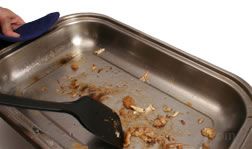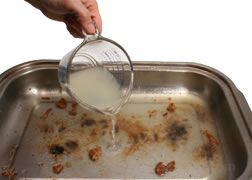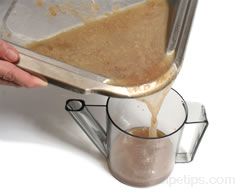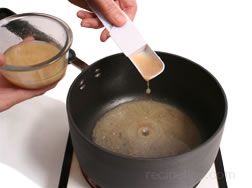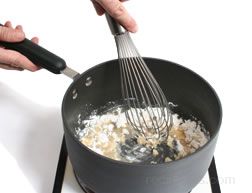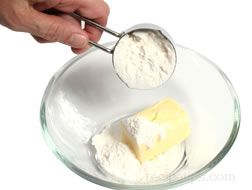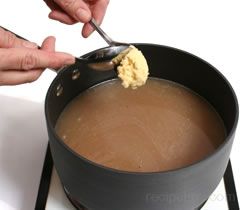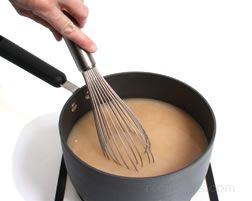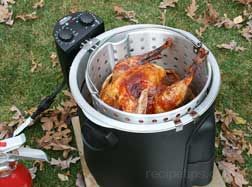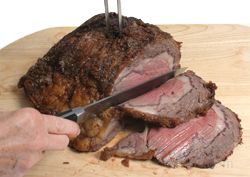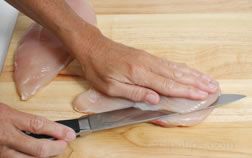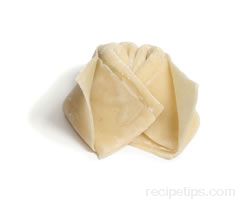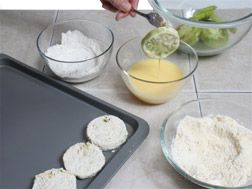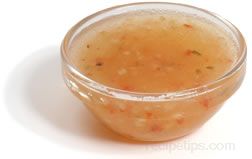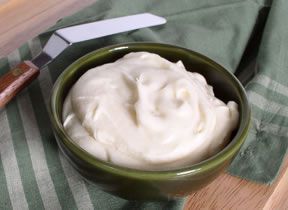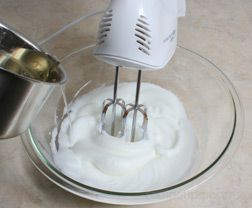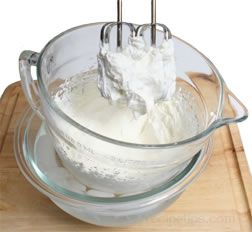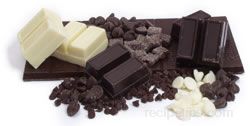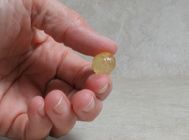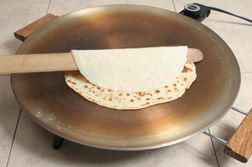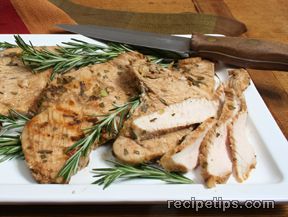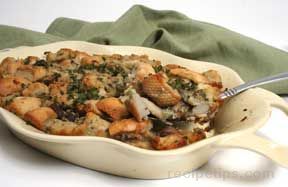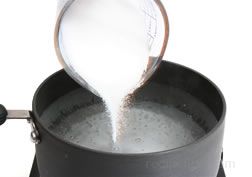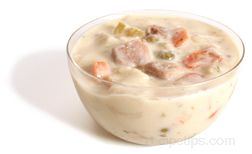|
Useful Tools | Making Gravy | Tips
There are many recipes available for making gravy but you will find that most use the turkey drippings, browned pieces from the bottom of the roasting pan, and a small amount of fat to give it great flavor and color. Following the guidelines shown below will help you produce smooth, flavorful gravy from the drippings produced when roasting the turkey.
Useful Tools
There are a few tools that can be used to make the gravy making process a little easier. Although these tools are not essential to gravy making, they are great in assisting the process.
| Gravy Separator |
|
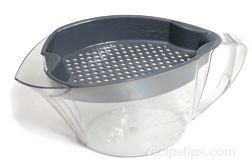 |
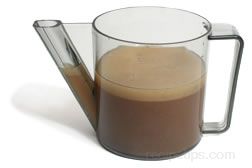 | |
A kitchen utensil that is used to separate the fat from the juices of the meat. The hot meat juices or any hot meat stock containing fat is poured into the separator and the fat rises to the top while the layer of the meat juices remain on the bottom. The spout extends down to the bottom where the juices are located, allowing them to be poured out while the fat remains on the top, making it easy to separate the two. Some varieties have a strainer that fits on top to aid in filtering out unwanted particles. |
|
Whisk
A wire whisk works goods when combining the fat and flour to make the thickening for the gravy. Also, when the cooking liquid is added to the thickening the whisk is the best tool for preventing lumps. |
|
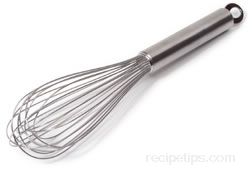 |
|
Strainer
The strainer is a good tool for eliminating unwanted particles in broth, dripping juices and the finished gravy. The liquid is poured through the mesh of the strainer and the particles are caught in the strainer because they are too big to flow through the openings in the mesh. |
|
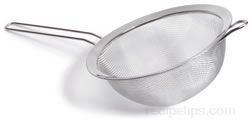 |
Making Gravy
Making Stock | Separating Fat | Deglazing | Determine Quantity
Gravy - Method #1 | Gravy - Method #2 | Gravy - Quick Method
Adjusting Consistency
There are different methods that can be used to make gravy, which require different steps and can produce different flavors. Follow any of the methods below to make smooth and flavorful gravy.
Making Stock
This processes can be eliminated if desired and the stock can be replaced with store bought broth, potato water, or plain water. Keep in mind that the type of liquid used for cooking liquid will affect the flavor of the gravy. The stock can be prepared while the turkey is cooking or it can be made a day a head of time and refrigerated until needed. If refrigerated, the fat will harden on the surface and be easy to remove.
|
Place the neck, heart, and gizzard in a saucepan and cover with water. Do not use the liver because it will cause the broth to be bitter. Add 1/2 teaspoon of table salt or 1 teaspoon of kosher salt and cook on high until boiling.
Note: Vegetables, such as onions, carrots and celery, can also be added for additional flavor. |
|
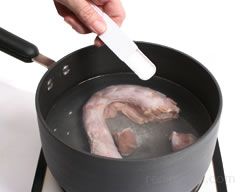 |
|
As the stock begins to cook, foam will form on the surface of the water. Skim off as much foam as possible and discard. |
|
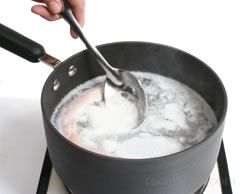 |
| Once it starts to boil, cover and turn the heat down to low. Allow the stock to simmer for approximately 45 minutes to an hour. |
|
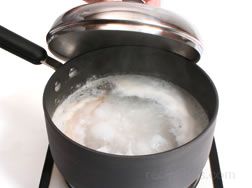 |
|
Remove giblets from the water and then pour into a bowl. If the stock contains a lot of unwanted pieces, you may want to pour through a strainer to separate them from the stock. Allow stock to cool slightly and then refrigerate until ready to use.
Note: Store purchased broth can also be used in place of the homemade stock. |
|
 |
Separating Fat from Drippings
Before starting to make the gravy, the fat should be separated from the juices so they can be used in different steps of the gravy making process.
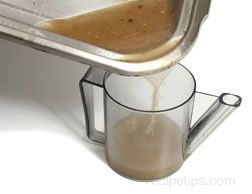 |
|
After removing the turkey from the roasting pan, pour the drippings (juices produced while turkey was roasting) into a gravy separator. If you do not have a separator, pour into a glass liquid measuring cup or a bowl. |
 |
|
Allow this liquid to settle for 4 to 5 minutes, allowing the fat to separate from the juices. The fat will rise to the top and the juices will settle to the bottom. |
 |
|
If using a gravy separator, pour juices into a 2-quart measuring cup until only the fat remains in the separator. After juices are removed, pour fat into a smaller bowl and set aside. |
|
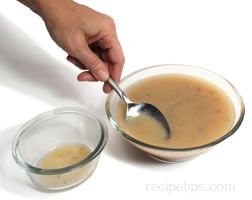
|
|
If not using a separator, remove fat from the top of the juices by skimming it off with a spoon and putting it in a smaller measuring cup or bowl. |
|
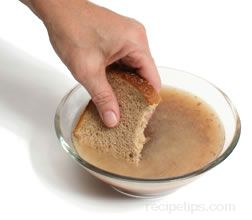
|
|
Any remaining fat on the surface of the juices can be removed by gently wiping a paper towel or piece of bread over the surface to soak up the fat.
Set juices and fat aside. |
Deglaze Roasting Pan
Determine Quantity of Gravy
When making gravy, it is often difficult to know how much fat (or butter if not using fat from drippings) and flour to use for thickening the cooking liquids. Start by determining how much cooking liquid you have for making the gravy. The cooking liquids include stock (homemade or store purchased broth) and juices from the drippings created during the roasting period.
| Pour the remaining stock into the measuring cup with the other juices to determine the amount of cooking liquids available. Determine if that will be enough for the number being served basing your estimate on 1/3 cup per serving. If there is not enough cooking liquid to make the desired amount of gravy, add store purchased broth or water to make up the amount necessary. If there is potato water available, it is also a good option for additional liquid. |
|
 |
Then to determine the amount of thickening needed, use the equation of 1 tablespoon of flour and 1 tablespoon of fat (or butter) per cup of cooking liquid. This is a good starting point, and then additional thickening or stock can be added to adjust the thickness of the gravy if necessary. See the chart below for a quick reference on how much cooking liquid and thickener is required.
| Quantity of Liquid and Thickening |
| No. of Servings |
Cooking Liquid |
Flour |
Fat (or Butter) |
| 6 |
2 cups |
2 tbsp. |
2 tbsp. |
| 8 |
2 2/3 cups |
2 2/3 tbsp. |
2 2/3 tbsp. |
| 10 |
3 1/3 cups |
3 1/3 tbsp. |
3 1/3 tbsp. |
| 12 |
4 cups |
4 tbsp. |
4 tbsp. |
| 14 |
4 2/3 cups |
4 2/3 tbsp. |
4 2/3 tbsp. |
| 16 |
5 1/3 cups |
5 1/3 tbsp. |
5 1/3 tbsp. |
| 18 |
6 cups |
6 tbsp. |
6 tbsp. |
| 20 |
6 2/3 cups |
6 2/3 tbsp. |
6 2/3 tbsp. |
Gray - Method #1
This method for making gravy uses a roux made from fat and flour for thickening the gravy.
Gravy - Method #2
There are several alternative methods that can be used for making gravy. All have the same basics to them, such as the use of pan drippings, broth and some type of thickening agent. Show below is an alternative method using a Beurre Manié, which contains flour and butter.
Gravy - Quick Method
This method requires the capability of using the roasting pan on the stovetop because the gravy is made in the pan in which the meat was cooked . It uses a roux for thickening where the fat and flour are cooked in the roasting pan and then the juices are added back in.
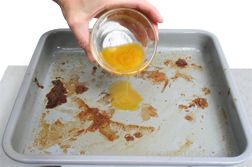 |
|
Pour off drippings and separate fat and juices as shown above. If desired, deglaze the pan as stated in Deglazing Roasting Pan above.
Determine amount of fat needed for the quantity of gravy being made and add back into the roasting pan. See the chart above to determine quantity of fat, flour and cooking liquid needed. |
Gather the cooking liquids to produce the necessary quantity. Cooking liquids can consist of juices from pan drippings, homemade stock, broth, potato water or water. Place the roasting pan on the stovetop over medium heat. If the roasting pan is large, it may be necessary to use two burners. |
|
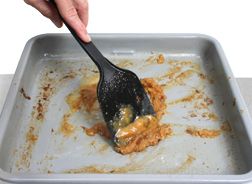
|
|
Sprinkle the four in the roasting pan and stir into fat. Cook fat and flour for approximately 2 minutes, stirring constantly. |
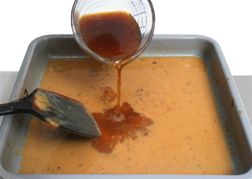
|
|
Gradually pour 1/2 cup of the cooking liquid to the roasting pan while stirring into the flour and fat mixture. Stir quickly to prevent lumps and to evenly mix the flour and fat with the liquid. The mixture will thicken quickly. |
As it thickens, begin adding more cooking liquid. Add approximately 1/2 cup at a time and stir until thorough mixed. Continue to add the cooking liquid in this manner until the mixture has a smooth texture and is the consistency desired. |
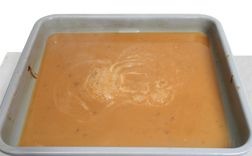 |
|
Bring the gravy to a simmer and cook for 5 to 10 minutes. After simmering, taste the gravy and seasoning with salt and pepper if desired. |
 |
|
If the gravy contains unwanted particles, pour it through a mesh strainer before serving. Pour into a serving bowl and serve while hot. |
Adjusting Gravy Consistency
If the consistency of the gravy is not as desired, there are methods that can be used to correct it. Follow the suggestions below.
Gravy Too Thick
- Add a small amount of broth and whisk into the gravy. Check consistency and if it is still too thick continue to add a little at a time, whisking in completely after each addition, until the gravy is at the desired consistency. Be sure to heat the gravy back to a boil after adding the broth.
- If there is not broth available to thin the gravy down, water can be used but if too much is used, it will start to dilute the flavor of the gravy.
Gravy is Not Thick Enough
- If time allows, simmer the gravy on the stovetop. This will evaporate some of the liquid in the gravy and help thicken it.
- Thoroughly mix 1 tablespoon of flour in 3 tablespoon of cold water until flour is completely dissolved in the water. Gradually add to the gravy, whisking constantly to prevent lumps from forming. If gravy is still not thick enough, repeat this process. Be sure the gravy is heated back to a boil after adding the flour and water mixture.
- Cornstarch can also be used to thicken the gravy. Mix 1 teaspoon of cornstarch with 1 cup of cold water and blend thoroughly. Add to the gravy in the same manner as indicated above with the flour and water mixture.
Tips
Gravy Tips
- To make gravy in the roasting pan or to deglaze it, be sure to use a pan that is heavy enough to use on the stovetop.
- To fix greasy/fatty gravy, soak grease up with a slice of fresh bread or drag an absorbent paper towel lightly across the surface.
- To thicken runny gravy, whip 1-2 tablespoons of instant potato flakes into gravy.
- Fix overly salty gravy by adding raw, sliced potatoes and cook them in the gravy until the potatoes appear translucent. Remove potatoes before serving.
- Slightly salty gravy may also be remedied by adding a couple pinches of light brown sugar. Be careful on how much is added or the gray may end up too sweet.
- To smooth lumpy gravy, try a whisk or rotary blender. If lumps remain, strain the gravy through a mesh strainer.
- To darken the color of gravy, add a ½ teaspoon of instant coffee.
- Darkening the gray can also be achieved by adding a little soy sauce. If a tablespoon or less of soy sauce is used per 8 cups of gravy, the taste will not be affected.
- A teaspoon of peanut butter will erase the burnt taste from gravy without altering the taste.
- A circle of wax paper placed on the top of cooling gravy will prevent the layer of skin from forming.
- Roast your turkey between 325°-350°F for the best pan drippings. Pan drippings consist of the clear liquid that accumulates in the bottom of the pan while the turkey is roasting. Higher roasting temperatures will decrease the amount of pan drippings available for gravy. Do not allow dripping to burn. If drippings start to dry up, add turkey or chicken broth to the roasting pan to prevent burning.
Flavor Tips
- For a twist, roast the turkey on a bed of celery and minced garlic. The flavors will be absorbed into the drippings used to make gravy.
- Stir a dash of soup stock, brandy, or port for a boost of flavor.
- If gravy is dull in flavor, add chicken or turkey bouillon.
- Proper seasoning is what can make the difference between good gravy and great gravy. Remember to add salt and freshly ground pepper.
Safety Tips
- Use a thermometer to ensure that your gravy has reached the proper heating temperature of 165° F before serving (a rolling boil).
- Store left over gravy in a shallow container, separate from potatoes and stuffing to prevent cross contamination. Leftover gravy is safe for up to 2 days when refrigerated but must be boiled to 165º F before serving (bring to a rolling boil).
- As with all leftovers, throw out any gravy that has been at room temperature for 2 hours.
|




















